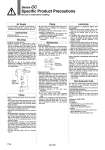
2-p1151-1165-cc_en 15 / 16
10秒後にBOOKのページに移動します
Series CC Specific Product Precautions Be sure to read before handling. Air Supply Environment Mounting Piping Maintenance Lubrication Fluid (Hydraulic fluid) . A mist separator prevents the intermixing of drainage, preventing the air-hydro unit from malfunctioning, and prolonging the life of the oil. . Avoid use near fire. . It cannot be used in the clean room. . Install the converter vertically. . Install the converter at a position that is higher than the cylinder. If placed lower than the cylinder, air accumulates in the cylinder. Use the air bleed valve on the cylinder to bleed the air. If the cylinder is not provided with an air bleed valve, loosen the hydraulic pipe to bleed. . Leakage associated with the sliding movement inevitably occurs. In particular, with the single side hydro unit, the operating oil that leaks to the pneumatic side will be discharged from the switching valve, thus soiling the switching valve. Thus, install an exhaust cleaner (Series AMC). (Fig. (6)) When the oil case of the exhaust cleaner becomes full, operating oil will blow out of the exhaust cleaner. Therefore, open the drain valve on a regular basis. . Before connecting the pipes, remove any foreign matter. . The {T Series W (white)} nylon tube can be used for hydraulic piping. Self-aligning fittings can be used for hydraulic piping, but One-touch fittings cannot be used. . Make sure that there are no extreme differences in the bore of the pipes used for hydraulic piping. Also check for protrusions or burrs. . Prevent air from being drawn into the hydraulic piping. . When operating a stop valve or a skip valve with a solenoid valve, considering it is an external pilot, provide pneumatic piping with 0.3 to 0.7 MPa of air pressure. The pressure for the pilot must be set to the operating pressure of the cylinder or higher. . When operating a stop valve or a skip valve with a solenoid valve, considering it is an external pilot, provide pneumatic piping with 0.3 to 0.7 MPa of air pressure. The pressure for the pilot must be set to the operating pressure of the cylinder or higher. . The stop and skip valves must be “normally closed”. Exhaust cleaner Series AMC . Be aware that the specified speed might not be attained if there is restriction in the fittings or there are 90° bends. . Air bubbles could form during operation due to cavitation. To prevent this: 1) Configure the piping from the cylinder to the converter to have an ascending gradient. 2) Shorten the hydraulic piping. 3) Port position should not be vertically downward. Double-side hydro . Even as a double side hydro unit, leakage occurs with the sliding movement of the air-hydro cylinder, increasing the converter's operating fluid in one area and decreasing it in the other. Fig. (7) provides a countermeasure circuit. Maintain the converter’s oil level at an appropriate level by opening valve A. Single-side hydro . The basic composition of the air-hydro system is the double side hydro; however, it can also be used as a single side hydro. The viscosity of the operating oil of the single side hydro is approximately one half of the double side hydro. The speed will be approximately 1.4 times the date given on page 10-17-3. When the system is used as a single side hydro, air could become intermixed with the operating oil, leading to the symptoms listed below: 1) Cylinder’s speed is not constant. 2) Stopping accuracy of the stop valve decreases. 3) Overrun of the skip valve increases. 4) The flow control valve with pressure compensator knocks (even with a small flow rate). Therefore, it is necessary to check periodically to prevent air from intermixing with the oil. If the symptoms described above occur, air must be bled. In particular, to prevent “4)”, use a double side hydro. Valve A Drain port (Piping port) If the converter is positioned higher than the cylinder: 1. Make sure to move the cylinder’s piston to the stroke end of the side that will be filled with oil. 2. Open the air bleeder valve on top of the cylinder. 3. If equipped with a stop valve, provide a pilot pressure of approximately 0.2 MPa to the stop valve, and maintain the stop valve in an open position through manual operation or by applying current. 4.Open the oil filler plug to fill with oil. When air no longer comes out intermixed with oil, close the cylinder’s air bleeder valve. Make sure that the oil level is near the upper limit mark on the level gauge, and replenish with oil if needed. 5. Next, fill the opposite side with oil. Move the piston to the stroke end of the side that will be filled with oil, and perform steps 1 through 4 in the same sequence as described above. If the converter is positioned lower than the cylinder: After filling with oil as described in step 4 above, close the oil filler plug. Then, introduce air pressure of approximately 0.05 MPa into the converter’s air port to push the oil into the cylinder. When air no longer comes out intermixed with oil, close the cylinder’s air bleeder valve. Perform the remaining steps in the same way as when the converter is located higher than the cylinder, in order to fill it with oil. . This operation necessarily causes air to accumulate in the cylinder during the operation of the cylinder. Therefore, air must be bled on a regular basis. Use petroleum based turbine hydraulic operating oil. The use of non-combustible operating oil could lead to problems. An appropriate viscosity is about 40 to 100 mm2/s at the operating temperature. Using ISO VG32 oil, the temperature range will be between 15 and 35°C. To operate in a temperature range that exceeds that of the ISO VG32 oil, use ISO VG46 (25 to 45°C). Turbine oil of ISO VG32 (Example)